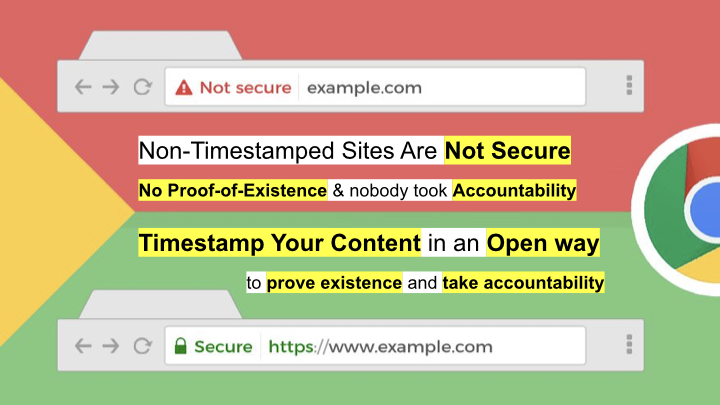On January 16th, 1 day after Drupal’s 19th birthday, the dutch Drupal community organized the 30th edition of Drupal Tech Talk. I had the pleasure to present a Pecha Kucha (20 slides x 20 minutes, what better way is there to start 2020?) on open-source, blockchain, and WordProof!
Firstly, here’s the video of the presentation, followed by every slide, the sentences I’ve used (in Pecha Kucha’s, I script every single line) and its source, where relevant. Enjoy!
Read further for a full transcript per slide of this Drupal Tech Talk on blockchain timestamps.

Hi all, my name is Sebastiaan van der Lans. Founder and owner of Amsterdam’s leading WordPress agency and I come in peace.
I founded the agency in 2006, and have worked full-time with Open Source software ever since.

Since last year, I work on something new, called WordProof. In an open-source manner, we restore trust in the broken web.
WordProof is a real-world use-case, with 162K timestamps.
Thanks for the invite to share our big idea with you.

The Web has a deep-rooted issue: trust.
How do consumers know whether the information presented by websites can be trusted, and how can content owners claim ownership?
We suffer from Fake-news, plagiarism, and revisionism.

And Social media? It was designed to use its users.
Just look at the business model:
- our content,
- our data,
- our attention.
These are all incredibly valuable things, but right now it’s the companies, not the users, that reap the rewards.

Dries Buytaert says, and I strongly agree: “I believe Open Source to be the only way to build a pro-privacy, anti-monopoly, open web.”
Let’s have a quick look at Closed versus Open Source and Software.

Let’s say we have three stakeholders: software, merchants, consumers.
With closed technology,
- as a merchant, I have to trust the software.
- as a consumer, I have to trust both the merchant as its software.
So, 3 trust relations are involved.

By working with open source, 2 of those 3 are eliminated. Everyone can verify the software. But as a buyer or reader, I still have to trust the merchant in not being evil.
How to fix the third and last trust relationship?

Ideally, all databases should be replaced with blockchains, making the full technology stacks transparent, auditable, and trustworthy. Let’s dive a bit in the technology to grasp what that’ll do.

Firstly, what is a database? In its simplest form, it’s a place where data can be inserted and updated. For example, content in your Drupal CMS; an article, a product. Anybody with access can do actions and read DBs states.

What is a blockchain? Nothing more than a database, but then distributed. Not one but many people run it. And those have consensus over its Save actions. Actions are only accepted after they all agree on it, and a block is a state.

In blockchains, everything is hashed. Every action, every block with actions. And every new block also includes a hash of the previous block, chaining the blocks to each other. Hence the word BLOCKCHAIN. Blocks with actions, reflecting the current DB state.

If I change one action in the past, ALL future blocks aren’t valid anymore; making it impossible to tamper with data without others noticing.
Example! Imagine Twitter replacing its DB’s with blockchain, making its technology stack fully transparent.

A tweet comes out from a CEO, and it violates some regulations. Stock prices go up or down. People make or lose hundreds of millions of dollars because of that tweet. People might end up in jail for that tweet.
And in fact …

We have no idea who actually said it, right? Did the CEO really say that, or does someone … inside Twitter modify the database? Or did some hackers from the outside corrupt the database? It’s totally not verifiable.

All of a sudden it could be used to escape accountability, “Oh, we don’t really know what happened”.
If apps like Twitter do build on blockchain, designed with integrity from the beginning, then there would never be any doubt about who said it.

So, replacing databases with blockchains does matter.
It allows us to commit to integrity by design, rather than just hoping it exists. In a few years, I expect Drupal and WordPress to replace MySQL with blockchains. Today blockchain is not ready yet, but …

The simplest form we CAN do today is timestamping hashes of content on-chain.
In five years from now, if you don’t timestamp your articles on the blockchain, you’re going to be considered a fraud. What are you hiding?

How WordProof works: In a standardized way, we hash content and we put its fingerprints on the blockchain. A certificate of birth!
And we provide tools to verify. Under a blog, link. Pop-up, scrolling through revisions.
Compare and check, Git-style!

If those timestamps become available via Schema.org, not only people but also social media and search engines can verify the existence, identity, and integrity, and if there hasn’t been tampered with any content.

Imagine products, terms & conditions being timestamped. And imagine as a journalist, linking not to an article, but to a revision of a specific article. Wouldn’t that change and improve commerce, journalism and therefore our democracy?
Let’s fix the broken web together, in the independent way we, as open source communities, already think, work and act. That’s what we aim to do at WordProof!
Help us to bring WordProof to Drupal. Reach out to me, and check out WordProof’s Github Repo.
THANK YOU to the dutch Drupal Community for the warm welcome.
This presentation is also available at PechaKucha.com: ‘Fixing the Broken Web with Blockchain Timestamps’